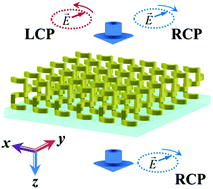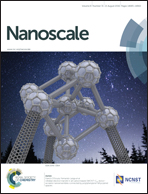Broadband circular polarizers constructed using helix-like chiral metamaterials†
Abstract
In this paper, one kind of helix-like chiral metamaterial which can be realized by multiple conventional lithography or electron beam lithographic techniques is proposed to have a broadband bianisotropic optical response analogous to helical metamaterials. On the basis of twisted metamaterials, via tailoring the relative orientation within the lattice, the anisotropy of arcs is converted into magneto-electric coupling of closely spaced arc pairs, which leads to a broad bianisotropic optical response. By connecting the adjacent upper and lower arcs, the coupling of metasurface pairs is transformed into the coupling of the three-dimensional inclusions, and provides a much broader and higher bianisotropic optical response. For only a four-layer helix-like metamaterial, the maximum extinction ratio can reach 19.7. The operation band is in the wavelength range of 4.69 μm to 8.98 μm with an average extinction ratio of 6.9. And the transmittance for selective polarization is above 0.8 in the entire operation band. Such a structure is a promising candidate for integratable and scalable broadband circular polarizers, especially it has great potential to act as a broadband circular micropolarizer in the field of the full-Stokes division of focal plane polarimeters.


 Please wait while we load your content...
Please wait while we load your content...